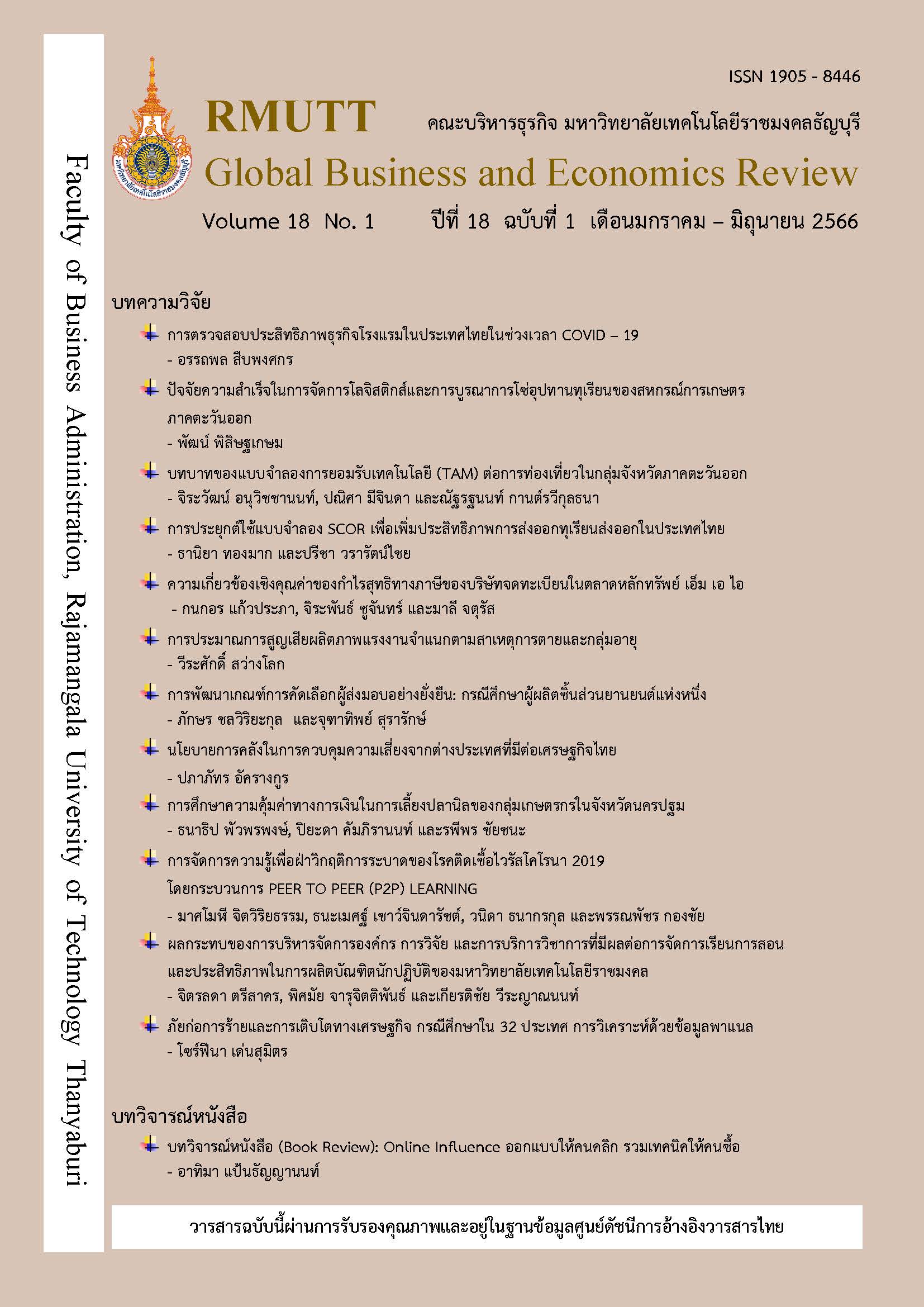KNOWLEDGE MANAGEMENT (KM): PEER TO PEER (P2P) LEARNING MODEL TO OVERCOME COVID-19 CRISIS
Keywords:
Management, Knowledge Management, Covid -19, Peer to Peer LearningAbstract
This qualitative research made use of in-depth interviews 1) to study the learning exchange model of to Peer (P2P) Learning 2) to guidelines for dealing with epidemic situation. The Informant person is the support staff 170 people working during the coronavirus pandemic 2019. Analyze the data by means of content analysis. Verify the quality by returning data back to the agency. The findings indicated that Peer to Peer (P2P) Learning is knowledge management in the organization using the SECI Model with the process Socialization, Externalization, Combination and Internalization. The guidelines are consist of 1) Communicating 2) Goals 3) Sharing 4) Data completion 5) Storage 6) Implementation. There are 5 supporting elements which are 1) People 2) Technology 3) Environment 4) Supporting factors 5) Things to learning. Knowledge spiral continually requires good interaction from working and confidence in the potential of personnel who can learn equally, it is the integration of various departments into a single solution on the basis of bringing the body of knowledge and relevant professions into practice.
References
กัตติกา ศรีมหาวโร. (2555). การใช้ระบบการจัดการความรู้เพื่อเพิ่มประสิทธิภาพการบริหารงานวิชาการของโรงเรียนขยายโอกาสทางการศึกษา สังกัดสำนักงานเขตพื้นที่การศึกษาประถมศึกษานครศรีธรรมราชเขต 4 : กรณีศึกษาโรงเรียนบ้านสระบัว. (วิทยานิพนธ์ดุษฎีบัณฑิต, มหาวิทยาลัยรังสิต).
จริยา ปันทวังกูร และกิตติศักดิ์ ดียา. (2563) การจัดการความรู้ในสถาบันอุดมศึกษา. วารสารวิชาการและวิจัย มหาวิทยาลัยภาคตะวันออกเฉียงเหนือ, 10(3), 289-303.
บดินทร์ วิจารณ์. (2550). การจัดการความรู้สู่ปัญญาปฏิบัติ (พิมพ์ครั้งที่2). กรุงเทพ: เอ็กซเปอร์เน็ท.
บูรชัย ศิริมหาสาคร และพัดชา กวางทอง. (2552). สรรพวิธีจัดการความรู้สู่องค์กรอัจฉริยะ. กรุงเทพ: แสงดาว.
ประพรรธน์ พละชีวะ, อังคนา กรัณยาธิกุล, ดนุชา สลีวงศ์ และเลอลักษณ์ โอทกานนท์. (2560). การใช้คอมพิวเตอร์สนับสนุนการเรียนร่วมกันเพื่อพัฒนาทักษะการคิดขั้นสูง. วารสารบัณฑิตศึกษา มหาวิทยาลัยราชภัฏวไลยอลงกรณ์ ในพระบรมราชูปถัมภ์, 11(3), 246-258.
ปราวีณยา สุวรรณณัฐโชติ.(2552). การเรียนรู้รมวมกันบนเครือข่ายคอมพิวเตอร์และการใช้คอมพิวเตอร์สนับสนุนการเรียนรู้รมวมกัน. วารสารครุศาสตร์, 37(3), 150-164.
พยัต วุฒิรงค์. (2550). ปัจจัยที่ส่งผลต่อความสำเร็จในการจัดการความรู้ภายในองค์การ. วารสารบริหารธุรกิจ, 30(116), 43-56.
พัชรา โพธิ์ไพฑูรย์ และพสุ เดชะรินทร์ (2564). การทำงานจากที่บ้านในช่วงการแพร่ระบาดของ COVID-19 ในประเทศไทย: ประโยชน์และความท้าทาย. วารสารบริหารธุรกิจ JBA, 44(169), 56-79.
รุ่งรดิศ คงยั่งยืน. (2564). การแบ่งปันความรู้. วารสารครุศาสตร์อุตสาหกรรม มหาวิทยาลัยเทคโนโลยีราชมงคลธัญบุรี, 7(2), 81-91.
วนิดา ธนากรกุล, ศลิษา ธาระสวัสดิ์, ธนะเมศฐ์ เชาว์จินดารัชต, กัญญาภัค เงินอินต๊ะ และวรยา ร้ายศรี. (2561). รูปแบบการถ่ายทอดความรู้สำคัญยิ่งยวดภายในและภายนอกศูนย์การแพทย์กาญจนาภิเษกผ่านนิทรรศการ. วารสาร Mahidol R2R e-Journal, 5(1), 17-29.
วิจารณ์ พานิช. (2551). การจัดการความรู้ ฉบับนักปฏิบัติ (พิมพ์ครั้งที่2). กรุงเทพ: สุขภาพใจ.
วิจารณ์ พานิช. (2559). ขอบฟ้าใหม่ในการจัดการความรู้ (พิมพ์ครั้งที่ 1). กรุงเทพมหานคร: มูลนิธิสถาบันส่งเสริมการจัดการความรู้เพื่อสังคม.
วิภาดา เวชประสิทธิ์. (2563). การจัดการความรู้ (Knowledge Management). สืบค้นจาก http://hsmi2.psu.ac.th/upload/forum/Phd_ Wiphada_slide.pdf
สถาพร พฤฑฒิกุล. (2558). เอกสารประกอบการฝึกอบรม “คุณภาพผู้เรียน.......เกิดจากกระบวนการเรียนรู้”. วันที่ 3 ธันวาคม 2558 ณ คณะเทคโนโลยีการเกษตร, มหาวิทยาลัยบูรพาวิทยาเขตสระแก้ว: สระแก้ว.
สมชาย นำประเสริฐชัย. (2558). การจัดการความรู้. กรุงเทพฯ: ซีเอ็ดยูเคชั่น.
สายสุดา ปั้นตระกูล. (2563). การจัดการเรียนรู้แบบเพื่อนช่วยเพื่อนของผู้เรียนที่มีความปกพร่องทางการได้ยินและผู้เรียนปกติ. วารสารร่มพฤกษ์ มหาวิทยาลัยเกริก, 38(2), 35-48.
Choudhury, P. (2020). Our work-from-anywhere future. Harvard Business Review, 98(6),58-67.
Giordana, S. & Wedin, B. (2010). Peer mentoring for multiple levels of nursing students. Nurs Edu Perspect, 31(6), 394-396.
Horne, C. V., Frayret, J. M., & Poulin, D. (2005). Knowledge management in the forest productsindustry: The role of centres of expertise. Computer and Electronics in Agriculture, 47, 167–184.
Jianhua, Z., Kedong, L., & Akahori, K. (2001). Modeling and System Design for Web-Based Collaborative Learning. Retrieved from https://www.researchgate.net publication/228917718
Lehtinen, E. (2000). Computer supported collaborative learning: A review. Retrieved from https://www.researchgate.net/publication/250788384
Nilufar, Antonija & Warwick (2007) Supporting collaborative learning and problem-solving in a constraint-based CSCL environment for UML class diagrams. Computer-Supported Collaborative Learning, (2), 159–190.
Nonaka, I., & Takeuchi, H. (1995). The knowledge creating company: how Japanese companies create the dynamics of innovation. New York: Oxford University.
Sallis, E., & Jones, G. (2002). Knowledge management in education. London: Kogan Page.
Williams, B., & Reddy, P. (2016). Does peer-assisted learning improve academic performance?. A scoping review, 42, 23-29.
World Bank. (2002). What is Corporate Governance. Retrieved from http:// Encycogov.com./ atlsGorpGov. Asp
Downloads
Published
How to Cite
Issue
Section
License
Copyright (c) 2023 ธนะเมศฐ์ เชาว์จินดารัชต์, มาศโมฬี จิตวิริยธรรม, วนิดา ธนากรกุล, พรรณพัชร กองชัย

This work is licensed under a Creative Commons Attribution-NonCommercial-NoDerivatives 4.0 International License.
The articles published in this journal are the intellectual property of their respective authors.
The views and opinions expressed in each article are solely those of the individual authors and do not reflect the positions of Rajamangala University of Technology Thanyaburi or any of its faculty members. All components and content of each article are the sole responsibility of the respective authors. In the event of any errors, the authors shall bear full responsibility for their own work.








